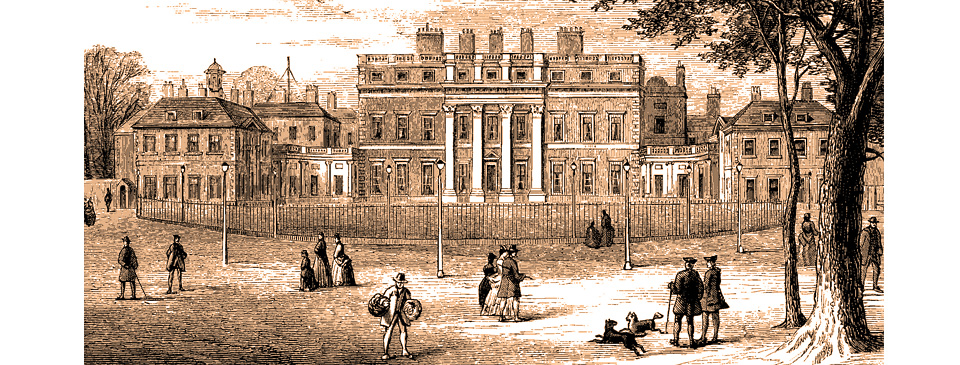Buckingham Palace

Buckingham House in 1775 after remodelling by Sir William Chambers for King George III. A mast on a roof to the left of the main building supported a weathervane connected to a wind dial over the chimneypiece in the library below. It enabled George to have an understanding of the movement of naval ships.
Part of the land on which Buckingham House was built had originally been taken from St. James’s Park under lease from the Crown. That complication allowed George III to acquire the entire site in 1761 from the Dukes of Buckingham for £21,000, including the house. St. James’s Palace. The King wished to use Buckingham House as a villa following his marriage to Queen Caroline of Mecklenburg.
George commissioned Sir William Chambers to modernise Buckingham House. The exterior was transformed from baroque into a neo-classical style. The forecourt was raised to hide the basement, and Tijou’s ornate railings replaced with a simpler style. Chambers re-designed the Duke of Buckingham’s large two-storey salon in a grey and gold neo-classical style, decorated by an Italian artist.
Four libraries, one of them octagonal, were created for the King’s growing collection of books, which numbered 67,000 volumes by the time of his death, as well as 18,000 maps and several thousand medals. These rooms were private to the King and only accessible through his bedroom. One person who was provided access by the librarian was Dr. Samuel Johnson. On one occasion when he was deep in study the King came to see him and a lengthy and learned discussion took place between them covering many topics. The collection later became the King’s Library in the British Library.
George inherited his interest in the arts from his father, Frederick, Prince of Wales, who had created a large number of paintings, and George continued to expand the collection for Buckingham House. Acquisitions for the royal collection included forty paintings by Canaletto and dozens by Francesco Zuccarelli. Of particular significance are those commissioned from the American-born artist Benjamin West. Other commissions were from Thomas Gainsborough and Allan Ramsay.
The initial work on Buckingham House cost £73,000 and took place between 1762 and 1774. Lancelot ‘Capability’ Brown landscaped the garden and in 1767 part of Upper St. James’s Park, now known as Green Park and then still only meadow, was appropriated to enlarge the garden where, in around 1772, Rosamond’s Pond was filled in. Buckingham House was then elegant but mostly of simple decoration. It was a family home, where fourteen of the royal couple’s fifteen children were born, the exception being the Prince of Wales (later the Prince Regent), who was born at St. James’s Palace.
The state rooms of St. James’s Palace continued to be used for official business. An Act of Parliament of 1775 transferred ownership of Buckingham House to Queen Charlotte, while at the same time the government took ownership of Somerset House. Charlotte continued to regularly use Buckingham House until her death in 1818 and during that time it was often known as Queen’s House.
During the Gordon Riots of 1780 George remained in Buckingham House from where messengers were constantly dispatched to observe the actions of the mob. Between three and four thousand troops surrounded the building, with the King spending much of the first night mixing amongst them.
As the King’s mental health deteriorated he spent most of his time at either Windsor Castle or Kew Palace and their son George became his Regent. Caroline was then granted an additional £10,000 per year for the upkeep of Buckingham House. She had the first-floor rooms rearranged and redecorated in a Regency style, more suitable for entertaining, and held her regular salons in the house instead of St. James’s Palace as previously.
The Prince Regent was then living nearby at Carlton House, which overlooked St. James’s Park from its north side. He had created it as a small palace, lavishly decorated, which he filled with superb works of art, some of which he had acquired from France after the royal palaces there were stripped of their treasures during the French Revolution of 1789. Carlton House was to be his rehearsal for his ideas for Buckingham House.
The heyday of Carlton House came in 1814 when the Prince gave a series of elaborate receptions there for the Allied sovereigns and commanders following the capture of Napoleon Bonaparte. Despite spending vast sums on the house over many years he thereafter lost interest in the building, finding it too small for his extravagant needs.
Caroline died in 1818 and Buckingham House stood unused. The Prince Regent announced his intention to Lord Liverpool, the Prime Minister, that he would move there but wished to make some alterations. The Prime Minister warned that the Treasury would not provide large funds. The following year Lord Liverpool agreed to a budget of £150,000 over three years. The Prince confided to his advisors that £450,000 would be required for what he had in mind.


